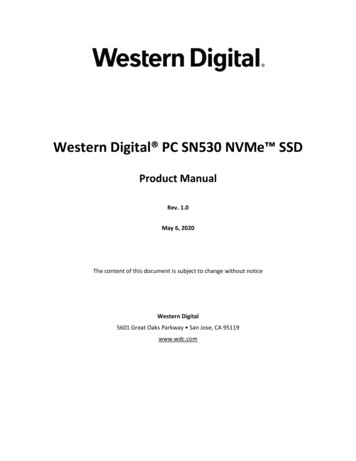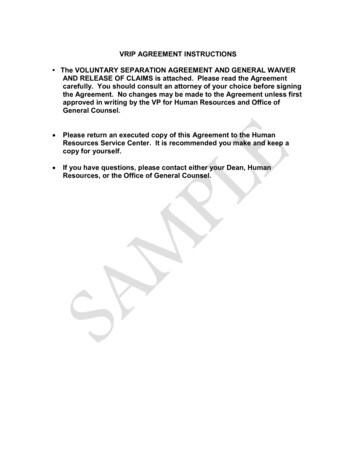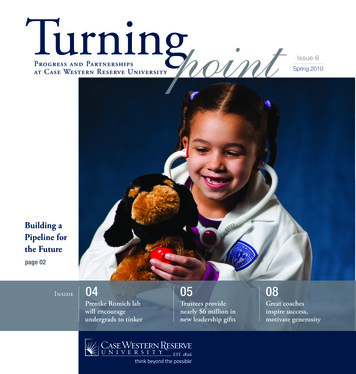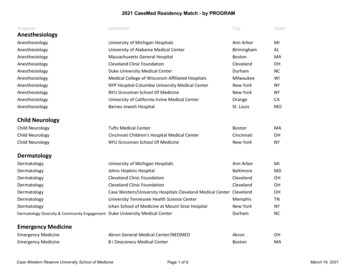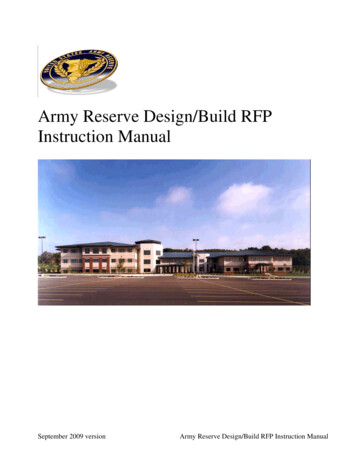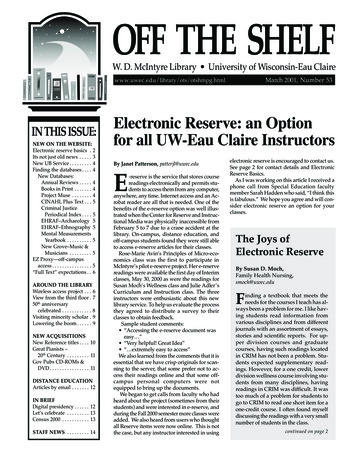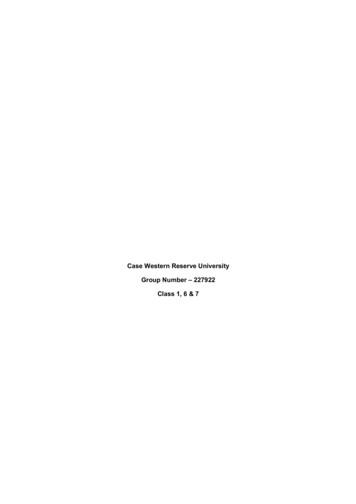
Transcription
Case Western Reserve UniversityGroup Number – 227922Class 1, 6 & 7
Consumers Life Insurance Company2060 East 9th StreetCleveland, OH 44115GROUP LONG TERM DISABILITY INSURANCECERTIFICATE OF COVERAGEPolicyholder:Case Western Reserve UniversityPolicy Number:227922Policy Effective Date:January 1, 2012Consumers Life Insurance Company (referred to as “the Company,” "we," "us," or "our")welcomes you as a client.This is your certificate of coverage as long as you are eligible for coverage and you becomeinsured. You will want to read it carefully and keep it in a safe place.Your certificate of coverage is written in plain English. There are a few terms and provisionswritten as required by insurance law. If you have any questions about any of the terms andprovisions, please consult our claims paying office. We will assist you in understanding yourbenefits.If the terms and provisions of the certificate of coverage (issued to you) differ from the policy(issued to the Policyholder), the policy will govern. Your coverage may be canceled or changedin whole or in part under the terms and provisions of the policy.The policy is delivered in and is governed by the laws of Ohio and to the extent applicable bythe Employee Retirement Income Security Act of 1974 (ERISA) and any amendments. Whenmaking a benefit determination under the policy, we have discretionary authority to determineyour eligibility for benefits and to interpret the terms and provisions of the policy.For purposes of effective dates and ending dates under the group policy, all days begin at12:00 midnight and end at 12:01 a.m. at the policyholder's address.WARNING: Any person who, with intent to defraud or knowing that he is facilitating a fraudagainst an insurer, submits an application or files a claim containing a false or deceptivestatement is guilty of insurance fraud.C-1 OHCLGRLTDC1000 R12/102
TABLE OF CONTENTSYour certificate is divided into the following sections:SECTION 1 - HIGHLIGHTS OF YOUR PLANSECTION 2 - GENERAL INFORMATIONSECTION 3 - ELIGIBILITY FOR COVERAGESECTION 4 - BENEFIT SPECIFICS disability defined details on calculating benefit payments exclusions and limitations that may applySECTION 5 - CLAIM INFORMATIONSECTION 6 - ADDITIONS TO YOUR LTD PLANFor your ease in finding information in your certificate, we: Start each section with a summary of the contents and the terms we define in the section.Shade all of the defined terms within a section.C-2CLGRLTDC1000 R12/103
SECTION 1: HIGHLIGHTS OF YOUR LTD PLANThis is a brief overview of your plan of benefits. We refer to these terms often throughout thiscertificate. Whenever we use these terms in the certificate, they have the following meaning,unless we advise you otherwise.Eligible Class Class 1: All Benefits Eligible Faculty and Senior Staff who work at least 18.75 hours per week(non-exempt; 20 hours per week – exempt) for the employer on a regular basis and Faculty andSenior Staff employees who are on sabbatical or Convenience leave and who retain benefitseligibility. (CWRU Benefit category 0 & 1)Class 6: School of Medicine Faculty members who are (1) Professors, Associate Professors,Assistant Professors, Senior Instructors, or Instructors with qualifications for professional rankas determined by the appropriate faculty body, and (2) are tenured, tenure-track, or non-tenuretrack members of the University Faculty, and earning any portion of their compensation fromthe University but who are not eligible to receive health insurance benefits under the BenelectPlan (i.e. those designated in Case Western Reserve University’s HRIS system with theemployee class “Faculty Retirement Only”).Class 7: Designated Non-School of Medicine Faculty members who are (1) Professors,Associate Professors, Assistant Professors, Senior Instructors, or Instructors with qualificationsfor professional rank as determined by the appropriate faculty body, and are tenured, tenuretrack, or non-tenure track members of the University Facutly, and (2) earning any portion oftheir compensation from the University but who are not eligible to receive health insurancebenefits under the Benelect Plan, (i.e. those in Case Western Reserve University’s HRISsystem with the employee class “Faculty Retirement Only”)Class 1: You must be working at least the minimum hours per week indicated in the aboveclassification.Class 6 & 7: You must be working at least 30 hours per week.Benefit Percentage 60%Maximum Payment Amount 6,000**We may reduce the amount we pay to you by other income amounts and any incomeyou earn or receive from any form of employment. Some disabilities may not becovered under this plan.Minimum Payment Amount 100We may apply all payments to you toward overpayments.Elimination Period 180 daysCLGRLTDC1000 R12/104
Pre-disability earnings means your gross monthly rate of earnings from the employer in effectjust prior to the date disability begins. It includes earnings from commissions, but not bonuses,overtime pay or other extra compensation. Commissions received will be averaged for thelesser of:1. the 12 month period of employment just prior to the date disability begins;OR2. the period of employment.If your disability begins while you are on a covered layoff or leave of absence, we will use yourpre-disability earnings from the employer in effect just before the date your absence begins.Our payments to you will be based on the amount of your pre-disability earnings covered by thisplan and for which premium has been paid.EE-1L-1 Rev 10/05CLGRLTDC1000 R12/105
SECTION 1: HIGHLIGHTS OF YOUR LTD PLAN(continued)Maximum Payment DurationAge WhenDisability BeginsMaximum Payment DurationLess than Age 60Age 60Age 61Age 62Age 63Age 64Age 65Age 66Age 67Age 68Age 69 and overTo age 65, but not less than 5 years60 months48 months42 months36 months30 months24 months21 months18 months15 months12 monthsWaiting Period:If you are in an eligible class on or before the plan effective date: NoneIf you are entering an eligible class after the plan effective date: First business day of themonth coindident with or next following date of hireIf your employment ends and you are rehired by the same employer within 1 year, we will applyyour previous employment in an eligible class toward completing the waiting period. All otherprovisions of this plan apply.Cost of Coverage:The employer pays the cost of your coverage.Waiver of Premium: The cost of your coverage will be suspended for any period of time duringwhich you are disabled under this plan and eligible to receive a monthly payment from us. Ifyou return to active employment with the employer, and want your coverage to continue, thecost of your coverage must begin to be paid again.EE-1L-2 Rev 10/05CLGRLTDC1000 R12/106
SUMMARY OF THE GENERAL INFORMATION SECTION 2What will you find in this section? information we have access tohow we use statements made in applying for coverageinsurance fraudtime limits for legal proceedingsWhat terms do we define in this section? LGRLTDC1000 R12/107
SECTION 2: GENERAL INFORMATIONWHAT IS THE CERTIFICATE OF COVERAGE?This certificate of coverage is a written statement prepared by us and may include attachments.It tells you: the coverage to which you may be entitled to whom we make paymentsAND the limitations, exclusions and requirements applying to a plan.You means an employee who is eligible for the coverage of this plan.We, us and our means the Insurance Company named on the first page of yourCertificate of Coverage.Employee means a person who is a citizen or permanent resident of the UnitedStates or Canada in active employment with the employer unless we advise youotherwise. This plan excludes temporary and seasonal workers from coverage.Employer means individual, company or corporation where you are in activeemployment, and includes any division, subsidiary or affiliated company named inthe policy.Insured means a person covered under this plan.Plan means a line of coverage under the policy.EE-2-1 Rev 5/98CLGRLTDC1000 R12/108
SECTION 2: GENERAL INFORMATION(continued)TO WHAT INFORMATION DO WE HAVE ACCESS?The employer will give us information about you including: if you are eligible for coverage if your amount of coverage changes, including salary change information if your coverage terminates other information we may reasonably require.The employer's records that we believe have a bearing on coverage under this plan are openfor our inspection at any reasonable time.Clerical error or omission will not: prevent you from receiving coverage affect the amount of your coverageOR effect or continue your coverage if it should not be in effect or continue in effect.HOW CAN WE USE STATEMENTS YOU OR THE EMPLOYER MADE IN APPLYING FORCOVERAGE?We consider any statements you or the employer made in a signed application for coverage arepresentation and not a warranty. If any of the statements you or the employer made are notcomplete and/or not true at the time they were made, we can: reduce or deny any claimOR cancel your coverage back to the date your coverage became effective.We will use only statements made in a signed application as a basis for doing this. You willreceive a copy of the signed application.EE-2-2CLGRLTDC1000 R12/109
SECTION 2: GENERAL INFORMATION(continued)HOW WILL WE HANDLE INSURANCE FRAUD?We promise to focus on all means necessary to support fraud detection, investigation, andprosecution. It is a crime if you or the employer knowingly, and with intent to injure, defraud ordeceive us, file a claim containing any false, incomplete or misleading information. Theseactions, as well as submission of false information, will result in denial of your claim, and aresubject to prosecution and punishment to the full extent under state and/or federal law. We willpursue all appropriate legal remedies in the event of insurance fraud.WHAT IF FACTS ABOUT YOU ARE NOT ACCURATE?If relevant facts about you were not accurate, then we will use accurate information to decide ifyour coverage should be in effect and what your amount of coverage should be. If the cost ofyour coverage is affected, we will make a fair adjustment in the cost.DOES THE EMPLOYER ACT AS YOUR AGENT?For all purposes of the policy, the employer acts on its own behalf or as your agent. Theemployer is not our agent.WHAT ARE THE TIME LIMITS FOR LEGAL PROCEEDINGS?You can start legal action regarding your claim 60 days after the date you sent us proof ofclaim. You have up to three years after the date you sent us proof of claim to start legal action,unless otherwise provided by law.DOES THIS PLAN REPLACE OR AFFECT ANY REQUIREMENT FOR WORKERS'COMPENSATION OR STATE DISABILITY INSURANCE?The plan does not replace or affect requirements for coverage by Workers’ CompensationInsurance or state disability insurance.EE-2-3CLGRLTDC1000 R12/1010
SUMMARY OF THE ELIGIBILITY FOR COVERAGE SECTION 3What will you find in this section? eligibility for coveragewaiting periodwhen coverage becomes effectiveevidence of insurability requirementswhat happens to coverage during a lay-off, leave of absence or a family or medical leave ofabsencewhen coverage under this plan endsWhat terms do we define in this section? waiting periodactive employmentwork siteevidence of insurabilitylayoffleave of absencefamily or medical leave of absenceEE-3-SummaryCLGRLTDC1000 R12/1011
SECTION 3: ELIGIBILITY FOR COVERAGEWHEN ARE YOU ELIGIBLE FOR COVERAGE?If you are in an eligible class you may apply for coverage under this plan on the later of: the date the plan is effectiveOR the date you complete the waiting period.WHAT IS YOUR WAITING PERIOD?Your waiting period appears in the PLAN HIGHLIGHTS.Waiting period is the number of days you must be in active employment in aneligible class before you may apply for coverage.If you have been continuously employed by the employer but were not in an eligibleclass, we will apply any prior period of work with the employer toward the waiting period.Active employment means you are: working for the employer at your work site for earnings the employer pays ona regular basis;AND performing the material and substantial duties of your regular occupation.Active employment includes normal non-work days such as vacation, weekendsand holidays.Your work site must be: the employer’s usual place of business; an alternative location if directed by the employer;OR a location to which your occupation requires you to travel.EE-3-1CLGRLTDC1000 R12/1012
SECTION 3: ELIGIBILITY FOR COVERAGE(continued)WHEN DOES YOUR COVERAGE BECOME EFFECTIVE?Your coverage will be effective on the day determined as follows:If you apply for coverage within the first 31 days after the date you are first eligible to applyAND-you are paying for some or all THENof the cost of your coverageyour coverage is effective onthe date you apply.OR-you are not paying for any ofthe cost of your coverageTHENyour coverage is effective onthe date you are eligible.EE-3-2CLGRLTDC1000 R12/1013
SECTION 3: ELIGIBILITY FOR COVERAGE(continued)WHEN IS EVIDENCE OF INSURABILITY REQUIRED?You will need to provide evidence of insurability to us with your application if you: apply for coverage more than 31 days after the date you are first eligible to apply;OR voluntarily terminate your coverage and want to reapply for coverage;OR apply for an amount of coverage for which we require proof of insurability.You must apply for coverage in writing through the employer and use an application form that issatisfactory to us. Your coverage will be effective on the date we approve your application.Evidence of insurability means a statement of your medical history which we willuse to assess if you will be approved for coverage.WHAT IF YOU ARE NOT IN ACTIVE EMPLOYMENT ON THE DATE YOUR COVERAGEWOULD BE EFFECTIVE?If you are not in active employment as a result of your injury or a sickness then your coveragewill be effective on the date you return to active employment. This applies to your initialcoverage, as well as any increases or additions to coverage occurring after your initial coverageis effective.WILL YOUR COVERAGE CONTINUE IF YOU ARE ON A LAY-OFF OR LEAVE OFABSENCE?Your employer may continue your coverage if you are on a lay-off or on an approved leave ofabsence. Your coverage may continue through the end of the month following the month inwhich your layoff or leave of absence begins. The cost of your coverage must be paid duringthe layoff or leave of absence period.Layoff or leave of absence means the employer has agreed in writing and inadvance to a temporary absence from active employment for a specified period oftime. Your normal vacation time or any period of disability is not considered atemporary layoff or leave of absence.EE-3-3 Rev 10/05CLGRLTDC1000 R12/1014
SECTION 3: ELIGIBILITY FOR COVERAGE(continued)WHAT HAPPENS TO YOUR COVERAGE IF YOU ARE ON A FAMILY OR MEDICAL LEAVEOF ABSENCE?If you are on a family or medical leave of absence, your coverage will be governed by theemployer's Human Resource policy on family and medical leaves of absence.We will continue your coverage if the following conditions are met: premiums for the cost of your continued coverage are paid;AND your leave is approved in advance and in writing by the employer.Your coverage will continue for up to the greater of: the leave period required by the Federal Family and Medical Leave Act of 1993, and anyamendments;OR the leave period required by applicable state law.While you are on an approved family or medical leave of absence, we will use earnings fromyour regular occupation you were performing just prior to the date your leave of absencestarted to determine our payments to you.If your coverage does not continue during a family or medical leave of absence, then when youreturn to active employment: you will not have to meet a new waiting period, including a waiting period for coverage of apre-existing condition;AND you will not have to give us evidence of insurability to reinstate the coverage you had ineffect before your leave began.Family and medical leave of absence means a leave of absence for the birth,adoption or foster care of a child, or for the care of your child, spouse or parentwho has a serious health condition as those terms are defined by the FederalFamily and Medical Leave Act of 1993 and any amendments, or by applicable statelaw.EE-3-4CLGRLTDC1000 R12/1015
SECTION 3: ELIGIBILITY FOR COVERAGE(continued)WHEN DOES YOUR COVERAGE UNDER THIS PLAN END?Your coverage under this plan will end on the earliest of the following: the date the policy or plan terminates the date you are no longer in an eligible class the date your class is no longer eligible for coverage the last day for which premium for your coverage has been paid the date you cease active employment due to a labor dispute, including but not limited tostrike, work slowdown, or lockout the date you cease active employment with the employer, unless you are disabled or on anapproved layoff or leave of absence.We will provide coverage for a payable disability claim that occurs while you are covered underthe policy or plan.EE-3-5 Rev 10/05CLGRLTDC1000 R12/1016
SUMMARY OF THE LONG TERM DISABILITY BENEFIT SPECIFICS SECTION 4What will you find in this section? what disability meanswhen monthly payments startreturning to work during the elimination periodrequirements of care from a doctorwhen will we not cover a disabilitywhat happens if the employer changes insurance plansour payment if you are disabled and not workingour payment if you are disabled and workingwhat are (and are not) other income amountscost of living increases to any other income amountspayment limitationswhen monthly payments stoptemporary recoveryWhat terms do we define in this section? disabilitymaterial and substantial dutiesregular occupationreasonable employment optiongainful occupationsicknessinjuryelimination periodregular caredoctorpre-existing conditiontreatmentprior group insurance planmaximum monthly paymentgross monthly paymentminimum monthly paymentmaximum capacityretirement plandisability benefits under a retirement planretirement benefits under a retirement planeligible retirement planmental illnesssubstance abusespecial conditionsmaximum payment durationEE-4L-Summary Rev 10/05CLGRLTDC1000 R12/1017
SECTION 4: LONG TERM DISABILITY BENEFIT SPECIFICSWHAT DOES DISABILITY MEAN?Disabled/Disability means our determination that your sickness or injury beganwhile you are covered under the policy and: during the elimination period and for the first 24 months of disability benefits,prevents you from performing with reasonable continuity the material andsubstantial duties of your regular occupation and a reasonable employmentoption offered to you by the employer and, as a result, the income you are ableto earn is less than or equal to 80% of your pre-disability earnings.After the first 24 months of disability benefits, prevents you from performingwith reasonable continuity the material and substantial duties of any gainfuloccupation and, as a result, the income you are able to earn is less than orequal to 80% of your pre-disability earnings.Material and substantial duties are the duties that: are normally required for the performance of the occupation;AND cannot be reasonably omitted or changed.EE-4L-1.3 Rev 10/05CLGRLTDC1000 R12/1018
SECTION 4: LONG TERM DISABILITY BENEFIT SPECIFICS(continued)Regular occupation means the occupation, as it is performed nationally, that youare routinely performing when your disability begins. Your regular occupationdoes not mean the job you are performing for a specific employer or at a specificlocation.Reasonable employment option means an employment position with the employerfor which you are able to perform the material and substantial duties given youreducation, training and experience. If you have been working in a reasonableemployment option for 6 months or more, the reasonable employment option willthen be considered your regular occupation.Gainful occupation means any occupation that your past training, education, orexperience would allow you to perform or for which you can be trained.Sickness means an illness or disease. It also includes an injury which occursbefore you are insured. It does not include risk of sickness.Injury means a bodily injury that occurs while you are insured and is the directresult of an accident and not related to any other cause. It does not include riskof injury.Related Rules:You will not be considered disabled from work in an occupation because of a reduction in yourearnings resulting from a change in economic conditions or other factors that are not directlyrelated to your sickness or injury. Examples of factors that we will not consider in determiningwhether you are disabled include, but are not limited to, recession, job obsolescence, jobrestructuring or elimination, pay cuts, and job sharing.You will not be considered disabled from work in an occupation solely because of:1.Your employer's work schedule that is inconsistent with the normal work schedule of yourregular occupation;2.Your relationship with your employer or other employees of the employer; or3.The physical relationship of your employer's workplace that is inconsistent with the normalphysical environment of your regular occupation.You will not be considered disabled from work in an occupation solely because of the loss,suspension, restriction, surrender, or failure to maintain a required state or federal license toengage in the occupation.You will not be considered disabled from work in an occupation solely because of your inabilityto work more than 40 hours per week in the occupation, even if you were regularly required towork more than 40 hours per week prior to becoming disabled.Your disability must begin while you are covered under the policy.EE-4L-2.2 Rev 10/05CLGRLTDC1000 R12/1019
SECTION 4: LONG TERM DISABILITY BENEFIT SPECIFICS(continued)DOES YOUR DISABILITY NEED TO CONTINUE FOR A PERIOD OF TIME BEFORE OURPAYMENTS TO YOU BEGIN?Your disability must continue through the elimination period before we begin making paymentsto you.Elimination period is a period of continuous days of disability. The eliminationperiod begins on the first day of your disability.WHAT HAPPENS IF YOU RETURN TO WORK DURING THE ELIMINATION PERIOD?We will consider your disability continuous if you: have one or more periods of temporary recovery during the elimination period for amaximum of 30 daysAND become disabled again due to the same sickness or injury.Temporary recovery means any time when we do not consider you to be disabled. The daysyou are not disabled will not count toward the elimination period.EE-4L-3.1 Rev 10/05CLGRLTDC1000 R12/1020
SECTION 4: LONG TERM DISABILITY BENEFIT SPECIFICS(continued)DO YOU NEED TO BE UNDER THE CARE OF A DOCTOR?We require you to be under the regular care of a doctor for the sickness or injury causing yourdisability in order to be eligible to receive payments from us.Regular care means: you personally visit a doctor as often as is medically required to effectivelymanage and treat your disabling condition(s), according to generally acceptedmedical standards;AND you are receiving appropriate treatment and care, according to generallyaccepted medical standards. Treatment and care for the sickness or injurycausing your disability must be given by a doctor whose specialty orexperience is appropriate.Doctor means a person: regularly performing tasks that are within the limits of the person's medicallicense;AND who is licensed to practice medicine and prescribe and administer drugs or toperform surgery; with a doctoral degree in Psychology (Ph.D. or Psy.D.) and whose primarypractice is treating patients; who is a legally qualified medical practitioner according to the laws andregulations of the jurisdiction in which regular care is being given.We will not recognize you, your spouse, children, parents, or siblings as a doctor for a claimyou submit.EE-4L-4CLGRLTDC1000 R12/1021
SECTION 4: LONG TERM DISABILITY BENEFIT SPECIFICS(continued)MAY WE REQUIRE YOU TO BE EXAMINED OR INTERVIEWED BY INDIVIDUALS OTHERTHAN THE DOCTOR PROVIDING REGULAR CARE?We may require you to be examined by doctor(s), other medical practitioner(s) or vocationalexpert(s) of our choice. We will pay for this examination. We can require an examination asoften as it is reasonable to do so. In addition, we may require an interview with you by anauthorized representative of ours.WHEN WILL WE NOT COVER A DISABILITY?We will not cover a disability if it is due to: war, declared or not, or any act of war; intentionally self-inflicted injuries or illness, while sane or insane; your active participation in a riot; your attempt to commit or your commission of a felony under federal or state law, or yourbeing engaged in an illegal occupation. your service in the armed forces, military reserves or National Guard of any country orInternational authority, or in a civilian unit serving with such forces; cosmetic or reconstructive surgery, except for complications arising from any such surgeryor for surgery necessary to correct a deformity caused by accidental injury or sickness; an accident resulting from or caused by your operation of a motor vehicle while intoxicatedaccording to the laws of the jurisdiction where the accident occurred; or an accident resulting from or caused by your being under the influence of drugs or anycontrolled substance, unless taken as prescribed by your doctor;No benefits are payable for any period of disability during which you are incarcerated ina penal or correctional facility for a period of 30 or more consecutive days or for whichyou are not under the regular care of a doctor.If your professional or occupational license or your certification is suspended, revoked orsurrendered, loss of your license or certification, by itself, does not mean you are disabled.EE-4L-5 Rev 10/05CLGRLTDC1000 R12/1022
SECTION 4: LONG TERM DISABILITY BENEFIT SPECIFICS(continued)WHEN WILL WE COVER A DISABILITY DUE TO A PRE-EXISTING CONDITION?We will cover your disability if it is caused by, contributed to by or results from a pre-existingcondition and your disability begins after you have been insured for 12 consecutive monthsafter the effective date of your coverage. If you do not meet this time period requirement, yourdisability is excluded from coverage under this plan.Pre-existing condition is a sickness or injury: for which you received treatment;OR where symptoms were present to the degree that an ordinarily prudent personwould seek treatment;within the three months prior to your effective date of coverage.Treatment includes: consulting with a doctor receiving care or services from a doctor or from other medical professionals adoctor recommends you see taking prescribed medicines being prescribed medicines you should have been taking prescribed medicines but chose not to receiving diagnostic measures.EE-4L-6.1.1 Rev 4/99CLGRLTDC1000 R12/1023
SECTION 4: LONG TERM DISABILITY BENEFIT SPECIFICS(continued)WHAT IF THE EMPLOYER CHANGES INSURANCE PLANS AND YOU ARE NOT IN ACTIVEEMPLOYMENT DUE TO AN INJURY OR SICKNESS ON THE EFFECTIVE DATE OF THISPLAN?Continuity of CoverageWe will cover you under this plan if you were insured by the prior group insurance plan, and thecost of your coverage under the prior group insurance plan was paid.Our payments to you will be limited to the monthly amount the prior group insurance plan wouldhave paid you had the plan stayed in effect. Our payments will be reduced by any amount theprior group insurance plan is responsible for paying.Prior group insurance plan means the group long term disability plan in effectwith the employer just before the effective date of this plan.EE-4L-7CLGRLTDC1000 R12/1024
SECTION 4: LONG TERM DISABILITY BENEFIT SPECIFICS(continued)WHAT IF YOU WERE INSURED BY THE PRIOR GROUP INSURANCE PLAN AND BECOMEDISABLED UNDER THIS PLAN DUE TO A PRE-EXISTING CONDITION?Continuity of CoverageIf you were insured by the prior group insurance plan just before you become eligible forcoverage under this plan; you are in active employment; and you are insured under this plan,then you may be eligible for payments from us under this plan if your disability is due to a preexisting condition.In order to receive payments from us, you must meet the pre-existing condition exclusion of: this plan;OR the prior group insurance plan had the plan stayed in effect.We will consider the total amount of time you were continuously insured under both the priorgroup insurance plan and this plan to determine if you satisfy the pre-existing conditionexclusion. If you cannot satisfy the pre-existing condition exclusion of either plan then we willnot pay you a disability benefit.We will determine our payments to you using the provisions of this plan, but your monthlypayment will not be more than the maximum monthly payment of the prior group insuranceplan. Your monthly payments will end on the earlier of the following dates: the end of the maximum payment duration under this plan;OR the date benefits would have ended under the prior group insurance plan if the plan hadstayed in effect.EE-4L-8CLGRLTDC1000 R12/1025
(continued)HOW MUCH WILL OUR MONTHLY PAYMENT TO YOU BE IF YOU ARE DISABLED ANDNOT WORKING OR DISABLED AND WORKING, EARNING LESS THAN 20% OF YOURPRE-DISABILITY EARNINGS?Our payment will be figured by using the following Steps 1 through 4:Step 1:Multiply your monthly pre-disability earnings by the benefit percentage.Step 2:Compare this amount to the maximum monthly payment for this plan.Step 3:Take the lesser of the amounts from Steps 1 and 2. This is your gross monthlypayment.Step 4:Subtract from the g
Consumers Life Insurance Company 2060 East 9th Street Cleveland, OH 44115 GROUP LONG TERM DISABILITY INSURANCE CERTIFICATE OF COVERAGE Policyholder: Case Western Reserve University Policy Number: 227922 Policy Effective Date: January 1, 2012 Consumers Life Insurance Company (referred to as "the Company," "we," "us," or "our") welcomes you .



